When thunderstorms approach the beach, watch for signs like darkening skies, distant thunder, or lightning flashes. Seek sturdy, enclosed shelters immediately and stay away from open areas, water, and tall objects. Use a safety zone at least 30 feet away from water and metal. Maintain a clear communication plan, listen for official alerts, and keep emergency supplies handy. Following these lightning protocols helps keep you safe—continue exploring to learn more about storm response strategies.
Key Takeaways
- Recognize storm signs like darkening skies, thunder, and lightning flashes, and seek shelter immediately in sturdy, enclosed structures.
- Use lightning detectors and official weather alerts to stay informed and respond quickly to approaching storms.
- Find safe shelters such as substantial buildings or enclosed vehicles, avoiding open areas, water, and tall objects.
- During a storm, move away from water and open spaces, crouch low if no shelter is available, and wait at least 30 minutes after the last thunder.
- After the storm, inspect the area for hazards, confirm safety, and resume activities only once it is declared safe.
Recognizing the Signs of an Approaching Storm
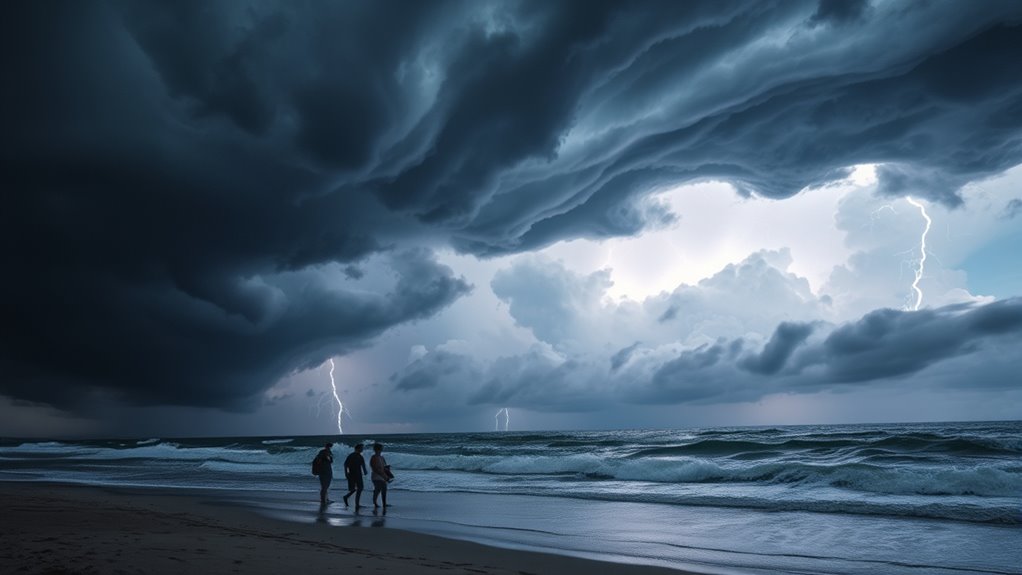
Recognizing the signs of an approaching storm is essential for your safety at the beach. You should watch for darkening skies, as thunderstorms often turn the sky a gray or greenish hue. Notice if the wind suddenly picks up or if the air feels heavy and oppressive—that’s a warning sign. Pay attention to distant thunder; if you hear it, a storm could be nearby. Lightning may be visible as flashes across the sky, even if the storm isn’t directly overhead. Additionally, if you see a rapid drop in temperature or notice the water receding quickly from the shore, these are signs the storm is approaching. Staying alert to these cues helps you act quickly and seek shelter before danger strikes. Understanding the chemistry of lightning can also help you appreciate why such signs indicate imminent danger. Being aware of storm prediction indicators enhances your ability to respond promptly and safely.
Establishing a Clear Emergency Communication Plan

Once you’ve identified the signs of an approaching storm, it’s important to have a plan for how you’ll communicate with others and get help if needed. Make sure everyone in your group knows how to reach each other quickly, whether through cell phones, walkie-talkies, or designated signals. Assign a specific person as the primary point of contact, so there’s no confusion during an emergency. Establish a meeting spot away from the water and lightning, and ensure everyone agrees on it beforehand. Keep a list of emergency contacts, including local authorities, lifeguards, and nearby medical facilities. Regularly test your communication plan to confirm everyone understands it. Clear, practiced communication helps you respond swiftly and safely when thunderstorms threaten. Additionally, practicing emergency preparedness can improve your response time and coordination during actual storms. Incorporating spiritual awareness into your safety routine can also promote calmness and clarity during stressful situations. Understanding lightning safety protocols can further help you stay protected during severe weather events.
Identifying Safe Shelter Locations on the Beach
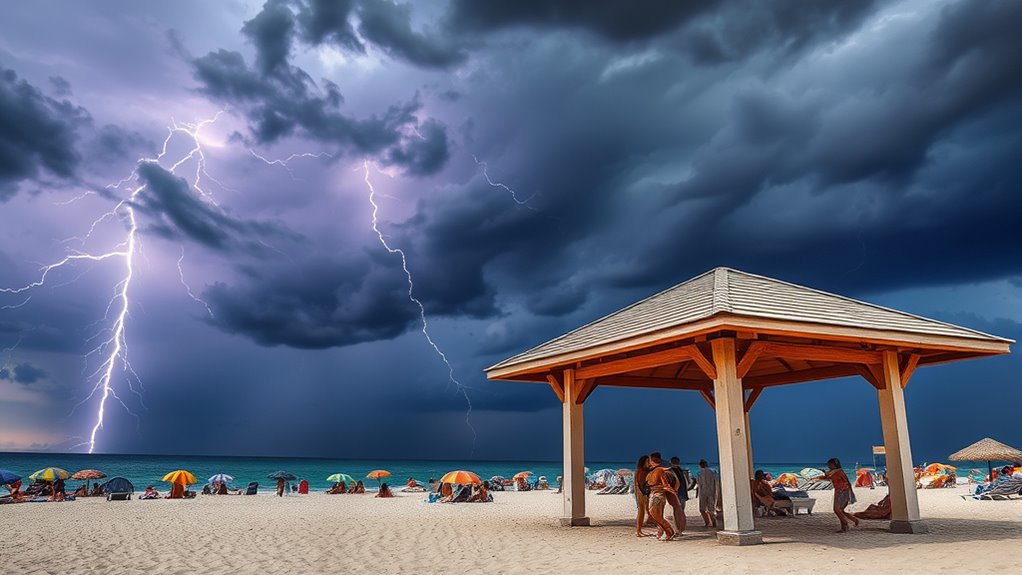
During a thunderstorm, finding a safe shelter quickly can make all the difference. Look for substantial structures like buildings, pavilions, or enclosed shelters that are grounded and have lightning rods. Avoid small or open-sided shelters, picnic pavilions, tents, or umbrellas, as they don’t offer adequate protection. If no building is nearby, seek a low-lying area away from tall trees, metal objects, and water. Never seek shelter under a lone tree or near metal fences, poles, or equipment, as lightning can strike these objects. Your goal is to find a sturdy, enclosed space that minimizes your risk of lightning strikes. Remember, the safest option is always a confirmed indoor shelter, so plan your route accordingly. Additionally, understanding the contrast ratio of nearby structures can help you identify which shelters are more likely to provide effective protection during a storm. It is also important to recognize that building materials can influence the safety of a shelter during lightning events. Being aware of lightning safety guidelines can further enhance your safety during thunderstorms at the beach. For example, knowledge of merchant services risks can help in understanding how to protect personal devices and payment systems from lightning-related damage when near electronic equipment. Furthermore, considering local weather alerts can ensure you receive timely updates about approaching storms, helping you to act quickly.
Immediate Actions When Thunderstorms Are Detected

When you hear the thunder grow loud or see lightning in the sky, take immediate action to protect yourself. Quickly move away from the water, open areas, and isolated objects like umbrellas or beach chairs. Seek shelter in a sturdy building or a designated lightning-safe area as soon as possible. If no shelter is nearby, crouch down low with your feet together, avoiding contact with the ground and other objects. Do not lie flat, as this increases contact with the ground’s electrical charge. Staying inside until at least 30 minutes after the last clap of thunder is crucial to ensure safety. Keep a close eye on weather updates and be ready to evacuate if conditions worsen. Acting swiftly can appreciably reduce your risk of lightning injury. Understanding local weather patterns can help you anticipate and respond to sudden thunderstorms more effectively. Additionally, being aware of Gold IRA investment principles can help you prepare financially for unforeseen events, including natural disasters. Recognizing beach safety signs and alerts can also provide critical information during storm situations. Being familiar with lightning safety guidelines can further enhance your preparedness during thunderstorms, especially when combined with awareness of emergency communication procedures to ensure you receive timely alerts.
Understanding Lightning Safety Zones and Distances
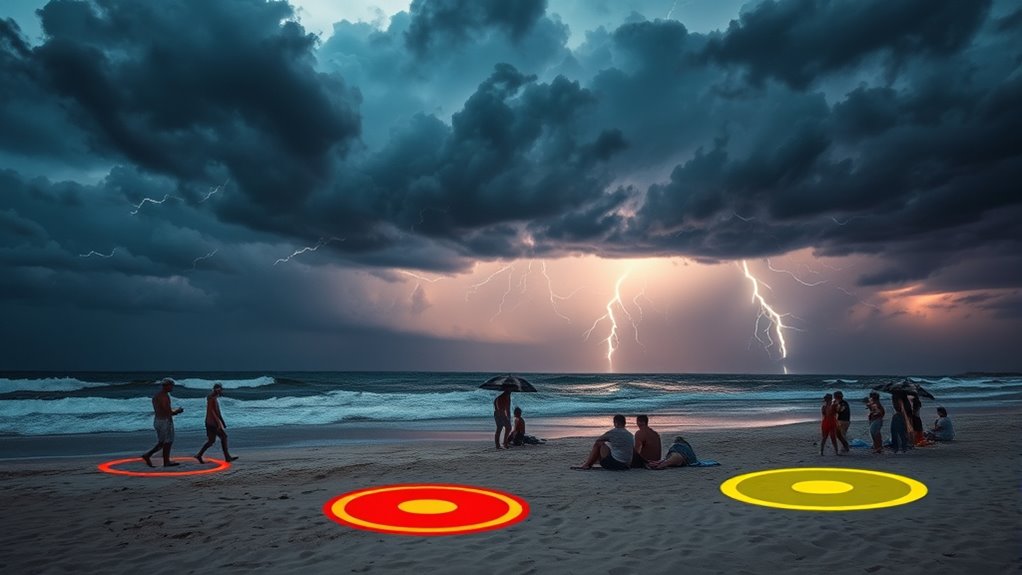
Knowing the safe distance to stay from lightning strikes is essential to staying safe at the beach. Lightning safety zones help you understand how far away a storm is and when it’s time to seek shelter. By monitoring weather alerts and following these guidelines, you can better protect yourself during thunderstorms. Recognizing the appropriate safety distance can prevent dangerous situations and ensure you remain safe during lightning events. Additionally, understanding how to interpret cookie categories can help you stay prepared and responsive to changing weather conditions. For example, many devices use headphone connectivity types to maintain proper audio performance, which can be affected by electrical storms.
Safe Distance Guidelines
Understanding lightning safety zones and distances is essential for protecting yourself during a thunderstorm at the beach. You should stay at least 30 feet away from water, umbrellas, and tall objects, as lightning can strike unexpectedly. The safe distance depends on the storm’s intensity and your surroundings. If you see lightning or hear thunder, move indoors immediately. Use the following guidelines to maintain proper distances:
| Object/Area | Minimum Safe Distance | Why It’s Important |
|---|---|---|
| Water (ocean, pools) | 30 feet or more | Water conducts electricity |
| Tall objects | 30 feet or more | Highest points attract lightning |
| Beach umbrellas | 30 feet or more | Can act as lightning rods |
| Open sandy areas | 30 feet or more | Lack of shelter increases risk |
| People | Maintain safe distance | To avoid lightning strikes |
Always prioritize safety and seek shelter at the first sign of a storm. Additionally, understanding appliance safety protocols can help prevent electrical hazards during outdoor storms. Staying aware of weather alerts and monitoring storm developments can further enhance safety measures. It is also advisable to avoid metal objects that can conduct electricity and increase risk during thunderstorms.
Lightning Safety Zones
Lightning safety zones are specific areas designated to minimize your risk during a thunderstorm. These zones are based on safe distances from lightning strikes, helping you avoid the most dangerous areas. Typically, you should seek shelter in a substantial building or a fully enclosed vehicle, which act as lightning-safe zones. If neither is available, the general rule is to stay at least 30 feet away from other people and tall objects, like trees or light poles. The goal is to reduce your exposure to lightning strikes and prevent injury. Remember, lightning can strike several miles away from a storm’s core, so even if the storm seems far off, stay alert and within your designated safety zones. Additionally, understanding lightning safety zones and their proper distances can greatly improve your safety during unexpected storms. Being aware of your surroundings and lightning strike risks helps in making quick, informed decisions to stay safe. Moreover, recent advances in lightning detection technology can provide early warnings, giving you more time to seek shelter.
Monitoring Weather Alerts
Monitoring weather alerts is essential to staying safe during thunderstorms, as it helps you track storm development and determine when to seek shelter. By keeping an eye on alerts from reliable sources like the National Weather Service or weather apps, you can receive real-time updates on lightning, wind, and storm movement. Pay attention to severe thunderstorm warnings and lightning alerts specific to your area. These notifications inform you when a storm is approaching or nearby, prompting you to act quickly. Always heed the advice given in alerts, and don’t wait until the storm is right overhead to react. Staying informed allows you to move to a safe lightning safety zone before the storm reaches you, minimizing your risk of injury.
Proper Use of Lightning Detectors and Weather Alerts
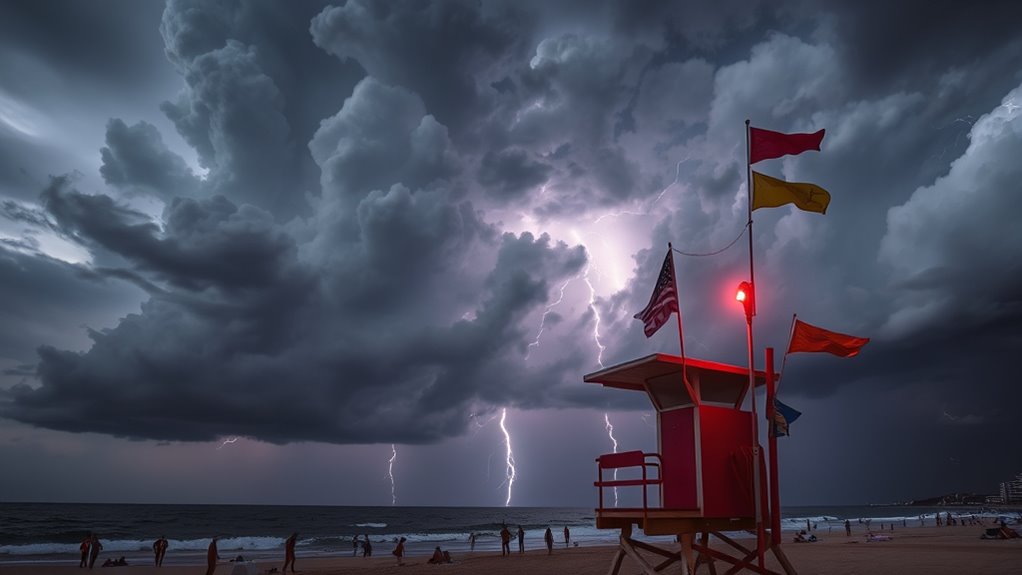
When you’re at the beach, staying safe during thunderstorms means knowing how to properly use lightning detectors and weather alerts. Lightning detectors can warn you of nearby strikes, giving you a critical heads-up to seek shelter. Make sure your detector is calibrated and functioning before heading out. Always listen to official weather alerts on your phone or radio, and act promptly when a warning is issued. To maximize safety:
- Keep your lightning detector within easy reach.
- Regularly check for updated weather alerts.
- Understand the device’s alarm signals.
- Follow instructions from official sources immediately.
Using these tools effectively helps you respond quickly and reduces your risk of lightning strikes. Being proactive with detectors and alerts ensures you’re informed and prepared during stormy weather.
Ensuring Group Safety During Storms

When thunderstorms approach, you need to recognize the signs early and act quickly. Make certain everyone in your group understands the importance of seeking shelter immediately and staying together. Keeping open communication helps guarantee everyone stays safe and knows what steps to take.
Recognize Storm Signs
Recognizing the signs of an approaching thunderstorm is essential for keeping your group safe at the beach. Being alert helps you act quickly and avoid dangerous situations. Look for these warning signs:
- Darkening skies or an unusual sudden change in weather
- Thunder sounds, even if distant
- Rapid drops in temperature
- Increasing wind speed or sudden gusts
If you notice any of these signs, stay vigilant and prepare to move to safety. Don’t ignore the visual or auditory cues, as they often indicate storms are nearby or imminent. Early recognition allows you to alert others and follow safety protocols promptly. Staying aware of these signs is vital to avoiding lightning strikes and other storm-related hazards, keeping everyone in your group safe until it’s time to seek shelter.
Seek Immediate Shelter
As soon as you notice signs of an approaching thunderstorm, it’s vital to act quickly to protect your group. Immediately move everyone to a safe shelter, such as a sturdy building or a vehicle, away from open areas, tall trees, and water. Do not seek shelter under umbrellas, trees, or near metal structures, as these increase lightning risk. Make certain everyone stays indoors and avoids contact with electrical appliances or plumbing. Keep the group calm and accounted for, making sure no one remains outside or in exposed areas. If you’re with children or vulnerable individuals, assist them in reaching safety promptly. Remember, lightning can strike suddenly, so swift action is imperative to prevent injuries and guarantee everyone’s safety during a storm.
Maintain Group Communication
Maintaining clear communication with your group is essential to guarantee everyone’s safety during a thunderstorm. You need to stay informed and assure everyone knows what to do. Use a reliable method, like a whistle, hand signals, or a phone app, to keep everyone connected. Regularly check in with your group members to confirm they’re accounted for and aware of the storm’s progress. Make sure everyone understands the shelter plan and knows how to reach designated safe spots. Keep a list of emergency contacts handy. You can also assign roles, such as a lookout or a communicator, to streamline coordination. Clear, constant communication minimizes confusion, helps manage panic, and ensures everyone responds quickly and safely to changing conditions.
Post-Storm Safety Checks and Resuming Activities
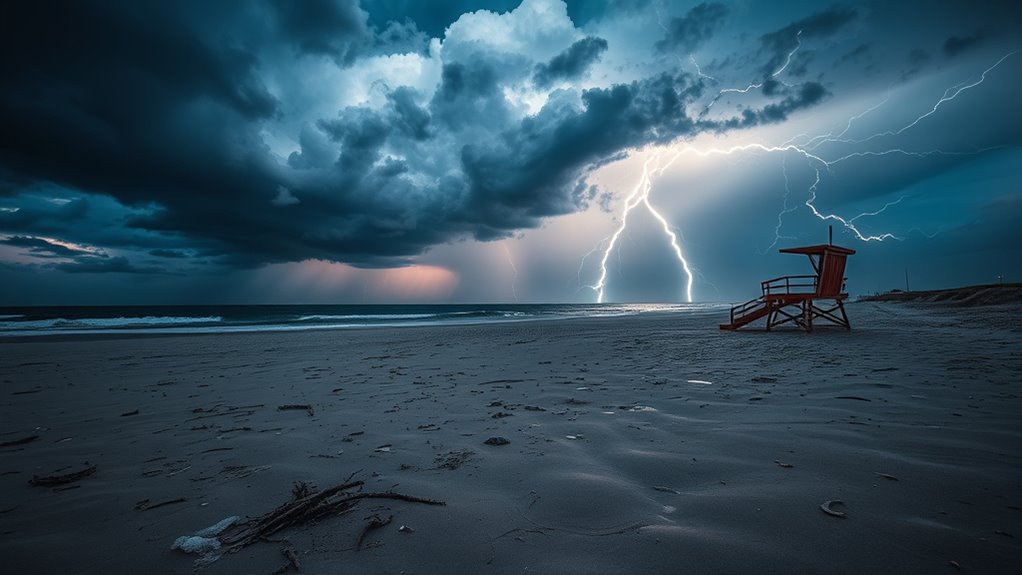
After a thunderstorm has passed, it’s crucial to thoroughly inspect the beach and surrounding areas before resuming activities. Check for any damage caused by strong winds or lightning, such as fallen trees, downed power lines, or debris that could pose hazards. Look for standing water or erosion that might make the ground unstable. Make sure all safety equipment, like lightning shelters, is intact and accessible. Confirm that warning systems are operational and that everyone is accounted for. Once you’ve completed the inspection and confirmed the area is safe, communicate clearly with beach visitors, advising them when it’s safe to return to water and activities. Never rush back into the water until you’re certain the environment is secure and free of hazards.
Educating Beach Visitors About Lightning Risks

To keep everyone safe, you need to teach beach visitors how to spot lightning signs and understand the risks. Clear communication about safety measures can prevent injuries and save lives. Making sure everyone knows what to do when a storm approaches is essential for a secure beach experience.
Recognizing Lightning Signs
Have you ever noticed darkening skies or a sudden drop in temperature while at the beach? These are vital signs lightning may be approaching. Recognizing these cues helps you act quickly to stay safe. Look out for:
- Dark, towering clouds that signal thunderstorms are forming
- Sudden drops in temperature indicating storm activity nearby
- Sound of distant thunder, which can occur miles away but still poses a risk
- Bright flashes of lightning illuminating the sky even before thunder is heard
If you notice any of these signs, it’s time to seek shelter immediately. Lightning can strike even when the storm seems far away, so staying alert and understanding these signs is essential for your safety at the beach.
Communicating Safety Measures
Recognizing the signs of lightning is just the first step; effectively communicating safety measures guarantees everyone at the beach understands how to respond quickly. Clear, visible instructions help visitors stay informed and act promptly during a storm. Use signs, loudspeakers, and staff announcements to relay vital information, such as seeking shelter immediately and avoiding open areas. To clarify safety procedures, consider this table:
| Safety Measure | Explanation |
|---|---|
| Seek Shelter | Find a sturdy, enclosed building |
| Avoid Water | Lightning can strike water easily |
| Stay Away from Trees | Trees attract lightning strikes |
| Listen for Alerts | Pay attention to sirens or announcements |
| Wait for Clearance | Stay inside until storm passes |
Consistent communication ensures everyone stays safe and minimizes confusion during thunderstorms.
Maintaining Preparedness With Emergency Kit and Supplies

Being prepared for a thunderstorm at the beach means keeping an up-to-date emergency kit and supplies readily available. You should regularly check and restock your kit to guarantee everything is functional. Essential items include:
- Flashlights and extra batteries for visibility if the power goes out
- A first aid kit for minor injuries or emergencies
- Bottled water and non-perishable snacks to stay hydrated and energized
- Weather-resistant clothing and blankets to stay warm and dry
Having these supplies on hand allows you to respond quickly and stay safe during sudden storms. Store your kit in a portable, waterproof container, and keep it accessible at all times. Being proactive in maintaining your supplies helps protect you and your loved ones from unexpected weather changes at the beach.
Frequently Asked Questions
How Can I Differentiate Between a Thunderstorm and Other Weather Phenomena?
To tell a thunderstorm apart from other weather phenomena, pay attention to the signs. If you see dark, towering clouds and hear thunder, you’re likely dealing with a thunderstorm. Lightning often accompanies these storms, so watch for sudden flashes. Unlike rain showers or drizzle, thunderstorms bring strong winds, heavy rain, and sometimes hail. Keep an eye on the sky and listen for sounds to identify a thunderstorm quickly.
Are There Specific Times of Day When Lightning Is More Likely to Occur at the Beach?
Oh, so you’re wondering when lightning prefers to crash your beach party? Well, it’s most active in the afternoon, especially between 2 and 4 p.m., when the sun’s heat stirs up the storm clouds. So, if you’re eyeing that perfect wave, remember this: the lightning’s favorite time to strike is when the sun is at its peak. Stay alert, and don’t be the lightning’s next target!
What Are the Long-Term Effects of Lightning Strikes on Beach Ecosystems?
You might wonder how lightning affects beach ecosystems over time. When a strike hits, it can cause immediate harm to plants and animals, but long-term, it can alter soil composition and nutrient levels, encouraging new plant growth. Some species may thrive or decline depending on how they adapt to these changes. Overall, lightning can reshape the local environment, influencing biodiversity and ecosystem stability for years to come.
How Do Weather Patterns Influence Thunderstorm Development Near Coastal Areas?
Weather patterns profoundly influence thunderstorm development near coastal areas. You can see that warm, moist air from the ocean rises and interacts with cooler, dry air, creating instability. When these air masses meet, they trigger convection, leading to thunderstorm formation. Additionally, factors like atmospheric pressure, wind shear, and local topography can enhance storm intensity and frequency, making coastal regions more prone to sudden, powerful thunderstorms.
Can Personal Electronic Devices Attract Lightning During Storms?
You might think that using your phone or tablet during a storm is harmless, but it’s like playing with fire. Personal electronic devices can act as lightning conductors, especially if plugged in or connected to headphones. Lightning seeks the easiest path to the ground, and your devices might attract it. It’s safest to keep electronics away and seek shelter immediately, because better safe than sorry when storms roll in.
Conclusion
Remember, thunderstorms can strike quickly — lightning causes about 25 million injuries worldwide each year. By recognizing storm signs, having a clear plan, and knowing safe shelters, you can protect yourself and others. Stay alert, act swiftly, and prioritize safety. Educate everyone on lightning risks, and keep emergency supplies handy. Being prepared can make all the difference in keeping your beach day safe and enjoyable, no matter what the weather brings.










